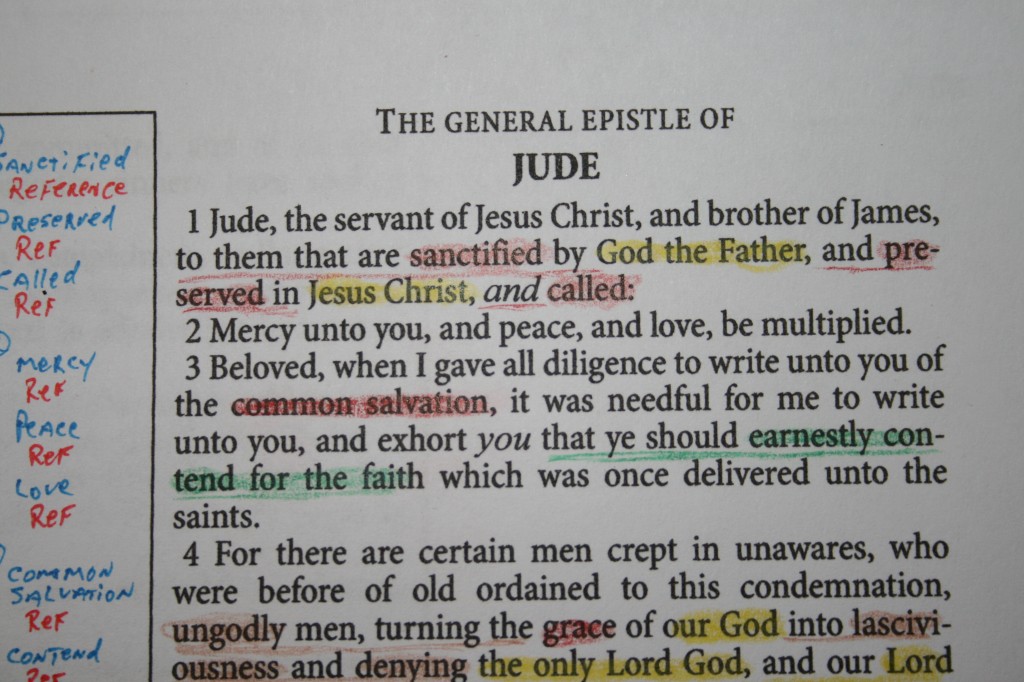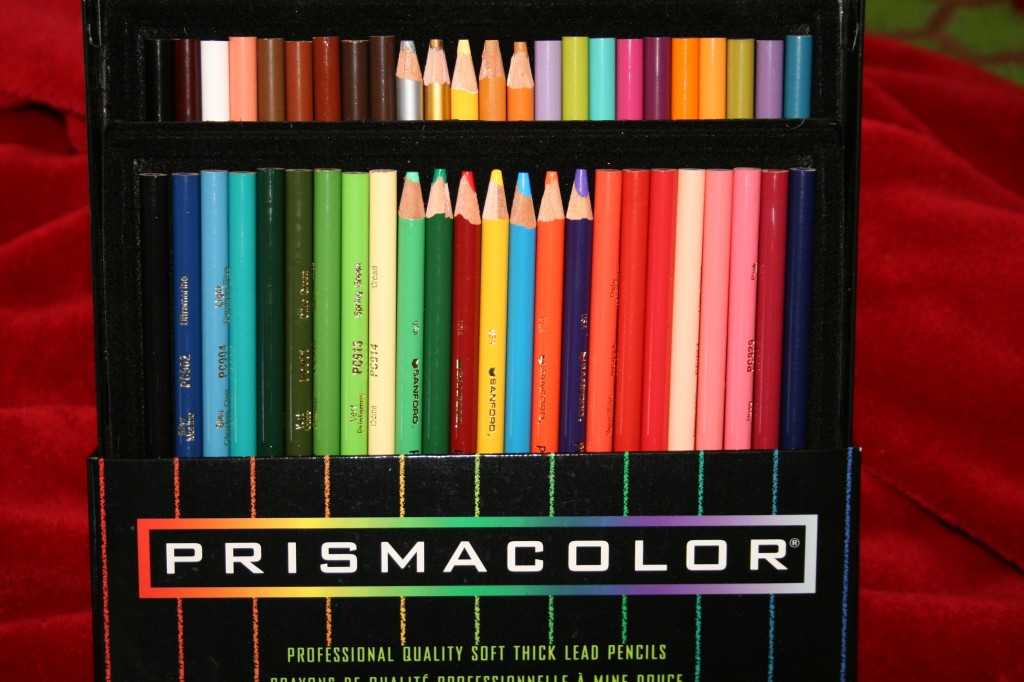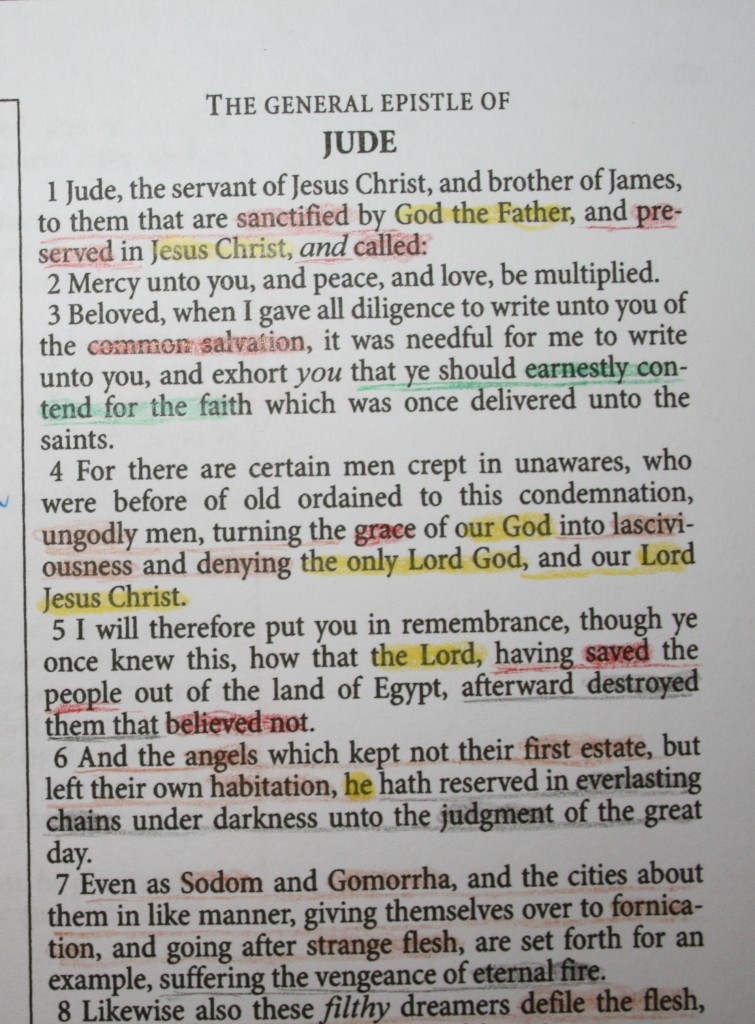I recently developed a new marking system for my new wide margin Bible. Since I got a new Bible I wanted to develop my color code a little more to include more subjects and get a little more detailed with my marking and study. I also wanted to refine my current subjects a little. My wife also uses my color code, and she added a few subjects of her own. I wanted to add her subjects and she wanted to add my new subjects. So, we collaborated and developed this new color code. We ended up with this new color code to go with my new marking system.
We are using PrismaColor Premier Color Pencils. The color names are the actual names of the PrismaColor pencils from the 48 count pack. There are over 60 colors available to buy individually for $1.50 each from Hobby Lobby (which is probably the best way to buy pencils for Bible marking).
Many years ago I started with around six colors. I’ve added colors over the years and developed my current color code, which consists of 12 colors. Here is my latest color code, which consists of 18 colors.
Canary Yellow – Godhead
Crimson Red – Salvation
Ultramarine – Holiness
Violet – Healing
Grass Green – Defending the Faith/Study the Word
Orange – End Time Prophecy
Black – Wrath of God/Judgment
Pink – Faith
Peach – Works of the Flesh
Yellowed Orange – Creation
Burnt Ochre – Science
Lilac – Gifts of the Spirit
Light Cerulean Blue – Fruit of the Spirit
Spring Green –Miracles
Dark Brown – Archaeology/Chronology
Light Aqua – Prayer
Tuscan Red – War
Process Red – Promises of God
There are plenty more topics to mark in the scriptures, but this will be enough for now. Other topics I would like to mark include money, music, and vocations. Not everything needs to be marked with a color, and many of these colors will not be used that often. Also, some of these topics overlap, which can make Bible marking difficult. My goal isn’t to mark every verse in the Bible and it isn’t to make my Bible look cluttered.
The purpose of this color code is so that my Bible study can become more involving and inductive. With my new marking system I am color-coding more verses than before, and the coding is part of my study process. This forces me to think more deeply about what is going on within each book, chapter, passage, and verse.
Some of the latest additions to my marking system are Creation, Science, Archaeology, War, and Promises of God.
Creation will cover every creative act of God.
Science will include scientific facts that the Bible proclaims. For example, the stars can’t be numbered.
Archaeology is the topic with the most diversity. I will mark anything that can be used in an archaeological study. This includes names, dates, places, and events. It will answer the questions: who, where, what, and when. For example, in the book of Daniel it talks about King Nebuchadnezzar, tells who he conquered, and when. This topic can actually be broken into several topics, but for my first time marking it I will just use one color. Later if I determine that it should be broken into more topics for my own study, I will change it when I go to another Bible. In my current Bible I will use marginal notes or symbols.
I constantly find that I want to mark a verse where God is promising something to someone, so adding Promises of God will be a nice addition.
I like pointing out the wars in scripture, so marking War will be a good addition, but it will overlap with Archaeology to some degree.
My wife has marked Prayer for years. It’s worked for her, so I added it to my list.
I’ve already started marking with this system and I have to say that I’m impressed that the colors are easy enough to tell apart.
Most people only use a small handful of colors, but 18 colors really aren’t too many. Color-coding is my version of inductive study. I’ve seen inductive study systems where people are using around 100 symbols. It’s far easier for me to remember 18 colors than 100 symbols. This marking system will last for several years’ worth of study, and will be a great benefit for going through the Bible and interacting with the text. The purpose of this marking system and color code is to promote good Bible study.




I have used a 6 color color coding system in the past. I now find myself using a classic notes bible (has a blank page between each page of scripture) to write out notes and my own commentary, as well as highlighting and a symbol coding system. It is a good thing which ever way you slice it, as long as your immersing yourself in God’s Word!
God bless!
Ryan
18 Colors is not that hard to remember you can also put a reference in the back of your bible with colors and what they go with. I was thinking of getting a set of erasable gel pens someone was talking about at another set or even the pentel pencil with its 8 colors. Thanks for the input though… Still thinking
Thanks David. I almost got the Pentel pencil. I just wanted more colors. I’m even considering adding another color for angels. Usually I would say this is too many colors (they can start to look too similar), but I wanted to enhance my inductive study and more colors seemed to fit the need. So far so good. I’ve gotten a lot more out of my study because of my new marking method.
Your idea of multiple colors simplifies the overly complex symbol method of inductive study, and your color-symbol associations make sense to me.
I have an important question: do the Prismacolors pencils bleed through thin Bible pages?
I used a brand years ago (name forgotten as the pencils were tossed) that, to my disgust, bled through. Am currently using Pentel’s 8-color “pen” which uses leads that have what I call, for lack of information regarding the lead’s content, a crayon consistency. The package of refills states it’s recommended by Kay Arthur of Precept Ministries. The pen is convenient to use, and the colors do not bleed through. My experience with gel pens is that they flow irregularly so I avoid them.
Thanks Suzanne. I appreciate the positive feedback. I have used PrismaColor pencils in my Thompson Chain Reference, which has thinner paper than my wide-margin Bibles, and in my World Heritage wide-margin, which is about the thinnest paper I have. There is a very faint bleed-through with some of the darker colors, but it’s not as dark as the text it is covering. It is barely noticeable. I never notice it because it blends with the text from the other side of the page. There are no indention’s in the paper. From what I’ve noticed with other pencils, I think PrismaColor pencils would be your safest choice. PrismaColor pencils are made for artists, so they’re a much better quality pencil than most cheaper pencils. In the past I’ve used Prang and Crayola pencils. I was pleased with them, but PrismaColor is much better. I will use PrismaColor pencils in every Bible I own. I haven’t used the Pentel ‘pen’, but I’ve heard it’s a good choice.
I have used the Pentel Pen for years and have been very happy with the results. It has not bled through and I have VERY thin pages. I have found that since I study my scriptures for different reasons I have begun to mark them with regard to what I was studying for (i.e. personal study, study with my husband, family study, church responsibilities, etc.) along with specific topics (i.e. faith, hope, charity, Christ, God, etc.). Because I want to be able to expand the number of topics I have been looking for quality colored pencils, so thank you for your post. I now know where to begin my search.
Thank You, Thank You!!! For these posts on how to color code various subjects. I have searched and searched for valuable information and your website offers the most useful information out there.
I just bought a set of prismacolor pencils and can’t wait to dive in and glean all that I can from the precious Word of God.
You are providing a tremendous resource to your readers. You are enabling us to dig deeper and to cherish the things of God.
Blessings on You!!!
Your site is fantastic! I just got my first ever bible and have been spending the last week & half researching how to mark in it to make it look nice and organized and also be effective to study. I’m not religious, but have always been interested in learning. Although I will read and study with an open mind, I am pumped that I found this site so I can try to learn all about the religion. I finally feel prepared to start studying! Thank you! I’ll definitely be checking this site out regularly for more info. I love it!
thanks for some great ideas on marking the bible… i have a few i am trying to set up myself, however i have been trying to find a way to color mark verses that show SIN.
i cant think of a god highlighter color to try.. red is normally salvation, and so forth, but i also want to mark scriptures that show SIN…
Hi Mark. I think it’s a good idea to color sin throughout the Bible. It’s hard to come up with good colors using highlighters because there are so few colors available. I use pencils because there are more colors to choose from. I use peach for sin. Sin is part of the Holiness topic. I use blue for Holiness. One possibility is to color sin as your Holiness color and then draw a symbol in the margin to indicate sin. Another possibility is to use the Holiness color but mark it differently (like drawing a square around the verse or something like that). If you do find a good color that works I’d be interested in hearing your solution.
Randy
I am a children’s ministry leader and am looking to incorporate the color method in my classes, I was wondering what you would suggest for children in grades 1-5 in range?
Hi Heather. Good question. I would suggest fewer colors and fewer subjects. I would also suggest coloring the entire verse or passage rather than breaking up the verses in detail. This is what we did for our children at this age. Our topics were Godhead, Salvation, Holiness, Healing, and I think one other but I can’t remember (that’s been a while- mine are graduated now). As far as your topics, I would suggest using the topics you teach the most. The Crayola pencils should be fine for them. I also suggest having a list and go through it with them (maybe grades 1-3) or give them some keywords and show them how to find the verses themselves (maybe grades 4-5). These are the first few things that come to mind. Let me know if you want more suggestions or have any questions. This sounds like a fun project.